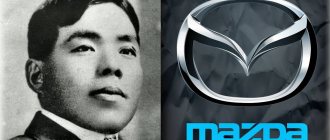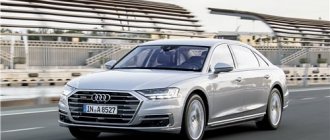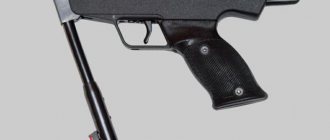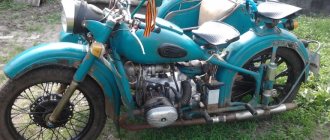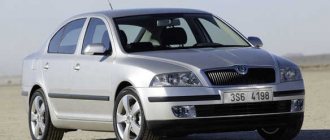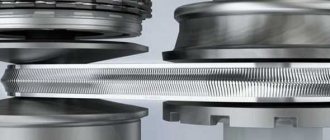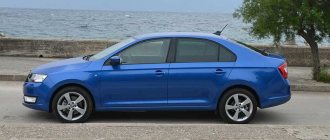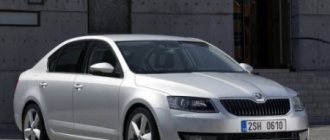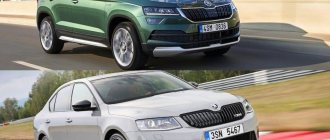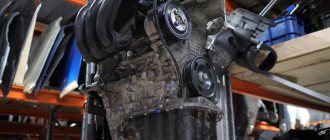"Skoda" - whose car? This car company has gone through a very long and difficult history. In 1925 it was acquired by the industrial conglomerate Škoda Works, which itself became state-owned in 1948. After 1991 it was gradually privatized and in 2000 Škoda became a subsidiary of the Volkswagen Group.
Škoda cars are sold in more than 100 countries, and in 2017 total global sales reached 1.21 million units, up 6.6% year-on-year, with an operating profit of €1.6 billion, an increase 34.6% more than the previous year. As of 2021, Škoda's profit margin was the second highest of all VW Group brands, behind Porsche. Those who do not know whose brand of car is Skoda need to consider how successful this automobile manufacturer is, having achieved success far beyond the borders of its native Czech Republic.
Story
The Škoda Works company was founded as a weapons manufacturer in 1859. Škoda Auto (and its predecessors) is one of the five oldest car companies and has an unbroken history alongside Daimler, Opel, Peugeot and Tatra. Those who don’t know whose Skoda car it is will find it difficult to believe that initially it was not a series of cars at all, but an arms concern.
In 1894, 26-year-old Vaclav Klement, who was a bookseller in the town of Mlada Boleslav, Kingdom of Bohemia (today's Czech Republic, then part of Austria-Hungary), was unable to obtain spare parts to repair his German bicycle. Clement returned his bike with a letter in Czech asking them to carry out repairs, and could only receive a response in German that said: "If you want an answer to your request, please try to write in a language we can understand." The same can be answered for people who still don’t know whose brand of Skoda car is - the country that produced this car is, of course, the Czech Republic, which at that distant time was part of Austria-Hungary.
Not satisfied with the response of the German manufacturers and realizing the business potential of this area of production, Clement, despite his lack of technical experience, decided to start a bicycle repair business, which he and Vaclav Laurin opened in 1896 in Mladá Boleslav. This wonderful city, whose production of the Skoda car is glorified in Czech history, often hosts excursions for car enthusiasts. At the same time, they prefer not to remember the bicycle, weapons and motorcycle periods of this company. Before entering into partnership with Clement, Laurin was a bicycle manufacturer in the nearby town of Turnov.
History of the Skoda brand
The history of the Skoda brand began back in 1895. The two Vaclavs - Clement and Laurin - were united by a broken bicycle, which the manufacturer did not care about. Their opinions agreed that only they themselves could produce high-quality bicycles. And then it was decided to create an entire production, because Clement and Laurin knew what they wanted to promote on the market: quality, reliability and accessibility.
Skoda logo
Production developed, and motorcycles began to be released onto the market. And in 1905, car production was launched, after which in 1920 there was a merger with a company called Skoda. This was the start for an entire empire. A little later, Skoda became part of the powerful Volkswagen concern.
Manufacturer country
Vaclav Klement and Vaclav Laurin - the founders - started their business in a small town near Prague, which was called Mlada Boleslav. The Laurin & Klement company was based there for a long time. But the development of the Skoda brand has made the company one of the most outstanding in the entire Czech Republic.
Czech Republic is a country. But other countries have also joined it, where there are now factories for the production of Skoda cars.
What does the emblem and name of the Skoda car mean?
The Skoda logo had nothing in common with the current design, nor did the Laurin & Klement badge. Even after the merger, there was no talk of any winged arrow. The logo had an oval shape; inside was the name of the company, framed by laurel branches. He didn’t have any decryption then.
Laurin & Klement badge
In 1926, a new form of logo appeared - the more familiar arrow with a bird's wing. But the question of who is the author of this original idea remains unanswered even now. Some claim that the idea belongs to Maglic, Skoda's commercial director, but this is just speculation.
Over time, the appearance of the Skoda logo was transformed and made more expressive. Thus, since 1999, the color blue has no longer been used in the symbol. The winged arrow began to be painted green, and the frame – black. This Skoda logo means environmental friendliness and fundamentality. A little later the coat of arms was made even more expressive. The arrow has become brighter and more voluminous, and the frame is lighter and more impressive.
The modern version of the Skoda emblem means originality of solutions, dynamism and lightness. This value was included during its development. The Skoda logo really stands out against the background of the emblems of other popular car brands.
Beneficial partnership
“Skoda” - whose car brand, what country? First of all, it is worth understanding that initially Skoda was not involved in cars at all. In 1898, moving into their newly built factory, the partners purchased Werner's Motorcycle. Lourin and Clement's first motorcycle, equipped with a handlebar-mounted engine driving the front wheels, turned out to be dangerous and unreliable - the last accident on it cost Lourin a front tooth. To develop a safer car with its own structure around the engine, they wrote to German ignition specialist Robert Bosch for advice on a different electromagnetic system. At that time, no one knew whose brand the Skoda car was, because at that time this company was producing motorcycles, not cars.
Their new motorcycle, the Slavia, debuted in 1899, and the company became Europe's first motorcycle factory. In 1900, with the company's new workforce, Slavia exports began and 150 vehicles were shipped to London for Hewtson. Soon after, the press named them as the creators of the first motorcycle.
Czech
In the case of the Skoda brand, its main country of production is the Czech Republic. And this is quite natural. The Czech automaker assembles on the territory of a European country. But this is not the only state within which the assembly is organized.
The main and largest production facility of Skoda is located in the city of Mlade Boleslav. It is here that almost all models available in the company’s product range are assembled. After assembly and preparation, the machines are sent to different countries around the world.
The plant operates around the clock and operates in shifts. This allows the production of new cars 24 hours a day to meet the growing demand for the Czech brand's model range. Most assembly processes are fully automated. People here mainly work in the field of monitoring, setting up and repairing assembly lines, servicing robots, and also dealing with small elements of the machine manufacturing process.
The main plant in the Czech Republic assembles over 2 thousand cars of different models, modifications and configurations per day.
In just 30 years of existence, more than 10 million Skoda cars were produced in the Czech Republic.
Switching to auto
By 1905, the company was producing cars, making it the second oldest car manufacturer in the Czech lands after Tatra. The company, with an area of 7200 m2, had a workforce of 320 people. and used 170 special machines, the steam power of which was 100 hp. The first model Voiturette A was successful, and the company became commercially successful both within Austria-Hungary and internationally. Austria-Hungary, a country whose Skoda car had yet to conquer the world market, later switched it to the production of weapons.
Weapons and cars
Meanwhile, the arms company and diversified concern in Pilsen, which became one of the largest industrial enterprises in Europe and the largest in Czechoslovakia, sought to expand its production base and acquired Laurin & Klement in 1925. It also began producing automobiles in collaboration with Hispano-Suiza. Most of the later production took place under the Škoda name. Whose Skoda car belongs to which country? At that time, this country was Czechoslovakia.
Since 1930, an assembly line has been used for production. In the same year, the car production was officially separated into a new company, Akciová společnost pro automobilový průmysl or ASAP for short. ASAP remained a 100% subsidiary of Škoda Works and continued to sell cars under the Škoda brand. In addition to the factory in Mladá Boleslav, it also includes representative offices, sales and service offices, as well as a central workshop in Prague. At that time, the automobile factory in Mladá Boleslav occupied an area of 215,000 square meters and employed 3,750 blue collar workers and 500 office workers.
Where is the Skoda Octavia assembled?
Briefly and clearly about where the Skoda Octavia car is assembled. What modifications and in which countries.
In the article: a list in which cities you can buy this car, three videos of how Skodas are assembled in the Czech Republic, Kaluga and Nizhny Novgorod, and a video comparing the assembly of Czech for Germany and Russian.
I also post the official Skoda websites of the countries where they are produced.
The official websites of the Skoda factories in Kaluga and N.N. are often asked.
There are no such sites./at the time of writing/
The maximum that is on the Internet is the VOLKSWAGEN Group Rus website - volkswagengrouprus.ru, which contains information about these factories and their addresses.
Well, before studying this topic, I thought that the Skoda Octavia was assembled only in the Czech Republic and Kaluga. But I surfed the Internet and found: (if I missed something, correct me)
Currently Skoda has 10 factories producing cars.
Czech Republic: official website https://new.skoda-auto.com/en
More complete contacts of the plant in the Czech Republic, e-mail written here >>
Mlada Boleslav main plant - Skoda Octavia Vrchlabi assembly plant - Skoda Octavia Tour and Skoda Octavia. Kvasin assembly - Roomster, Yeti and Superb.
Russia: official website of Skoda Auto in Russia skoda-avto.ru
Contacts of the Skoda representative office in Moscow can be found here >>
Kaluga - Octavia, Fabia. Nizhny Novgorod – Yeti Octavia
Ukraine: skoda.com.ua official website of Skoda Auto in Ukraine
Solomonovo – Octavia Fabia Superb, Yeti and Roomster
Kazakhstan: official website of Skoda Auto in Kazakhstan" skoda-auto.kz
Ust-Kamenogorsk — Superb, Yeti, Fabia Octavia Rapid
China
Shanghai - Yeti, Superb, Octavia, Rapid and Fabia
India
Pune, Aurangabad – Fabia Octavia Rapid Superb, Yeti skoda-auto.co.in
Sarajevo Bosnia and Herzegovina – Fabia was produced. Since 2008, production has ceased. Slovakia – since 2010 Skoda – Octavia has not been produced.
Comparison of Czech assembly for Germany and Russian - differences - 1st part >> Comparison of Czech assembly for Germany and Russian - differences - 2nd part >>
List of cities in which you can buy a Skoda
Moscow, St. Petersburg, Arkhangelsk, Astrakhan, Barnaul, Belgorod, Veliky Novgorod, Verkhnyaya Pyshma, Vladimir, Volgograd, Vologda, Voronezh, Yekaterinburg, Ivanovo, Izhevsk, Irkutsk, Kazan, Kaliningrad, Kaluga, Kamensk-Uralsky, Kemerovo, Kirov, Kostroma, Krasnodar, Krasnoyarsk, Kursk, Lipetsk, Magnitogorsk, Minusinsk, Murmansk, Naberezhnye Chelny, Nizhny Novgorod, Nizhny Tagil, Novokuznetsk, Novomoskovsk, Novorossiysk, Novosibirsk, Oktyabrsky, Omsk, Orel, Orenburg, Penza, Perm, Petrozavodsk, Pyatigorsk, Rostov -on-Don, Ryazan, Samara, Saratov, Severodvinsk, Sochi, Stavropol, Sterlitamak, Surgut, Syktyvkar, Tver, Tolyatti, Tomsk, Tula, Tyumen, Ulan-Ude, Ulyanovsk, Ufa, Khabarovsk, Chelyabinsk, Cherepovets, Yaroslavl
How Skoda is assembled in the Czech Republic
Skoda production in Nizhny Novgorod
Collections on the topic:
What is the difference between the Skoda Octavia A5 and the A5 FL
Chips of the Skoda Octavia A5
Car document cover and keychain with Skoda logo
Tell me how to distinguish the Czech assembly of Skoda from Kaluga?
New birth
Following the recession caused by the economic depression, Škoda introduced a new line of cars in the 1930s that was significantly different from its previous products. The new main tube chassis design and all-around independent suspension were developed under the direction of chief engineer Vladimir Matozny. The first model of the Škoda 420 Standard car was released in 1933 and was very popular - this is a fact that those who are interested in whose Skoda car needs to know.
The new chassis design became the basis for the Popular (845-1,089 cc), Rapid (1,165-1,766 cc), Favorit (1,802-2,091 cc) and Superb (2,492-3,991 cc) models in 1933 In 1936, Škoda had a 14% share of the Czechoslovak automobile market, but by 1936 the company had already become the leader of this market, having received a share of 39% in 1938.
Features of the Russian-assembled Skoda Rapid
Photo: this is how robots work in Russia
Due to the fact that Rapid is one of the company’s advanced models, it has received the most attention. Most experts believe that the Skoda Rapid can easily be included in the top three cars of the subcompact class. But this does not mean that the machine is designed ideally, and there are many ways to improve it.
It is worth noting that the Russian version, unlike the Ukrainian and Kazakh ones, is slightly different from the Czech Rapid. The differences appear in the following points:
- the Russian version is equipped with a 1.2-liter engine with a capacity of 76 horsepower;
- Recently, another gasoline engine appeared - a 1.6-liter unit that is capable of producing 106 “horses”;
- For the older gasoline unit, both a six-speed automatic transmission and a similar manual transmission are used.
If we analyze the reviews, it turns out that the best option would be a car equipped with a 1.6-liter unit paired with a six-speed automatic transmission.
Video: assembly of Skoda cars at the plant in Kaluga
War years
During the occupation of Czechoslovakia in World War II, the company became an enterprise of the Third Reich and began to serve German military interests, producing components for military vehicles, military aircraft, other weapons components and ammunition. Car production fell from 7,052 in 1939 to 683 in 1944, of which only 35 were passenger cars. Between January and May 1945, 316 trucks were produced. The United Kingdom and United States air forces bombed Škoda factories repeatedly between 1940 and 1945. The last massive air raid took place on 25 April 1945 and resulted in the almost complete destruction of Škoda equipment and the death (and injury) of around 1,000 company employees.
After the war
When the Mladá Boleslav factory was reconstructed by July 1945, production of the first Škoda car after World War II began with the 1101. It was essentially an updated version of the Škoda Popular. In the autumn of 1948, Škoda (along with all the other major manufacturers) became part of the communist planned economy, meaning that it was separated from the parent company Škoda Works. At that time, everyone knew whose car was Skoda.
At the end of 1959, the compact four-cylinder convertible coupe Škoda Felicia was imported to the United States. Its retail price was approximately US$2,700. That money could buy a well-equipped V8 car that was larger, more comfortable, and had more luxury and convenience features (gasoline sold for less than 30 cents per gallon, so fuel economy was not a high priority in America at the time). But the Felicias that made it to American buyers also had a number of reliability problems, which further damaged their reputation. They sold poorly in the States and have not been imported into the United States for retail sale since.
Our days
2010 was one of the important periods of change for Škoda Auto in terms of both production and management. September 1, 2010 prof. Winfried Faland took responsibility for the management of the company, becoming CEO of Škoda Auto. That same year, Škoda outlined plans to double the company's annual sales to at least 1.5 million by 2021.
In 2015, Škoda was voted the most trusted car brand in the UK. The corporate strategy was launched in 2015 to produce a range of electric vehicles from 2019.
Electric cars
In 2015, Škoda's new chairman Bernhard Maier said that the Volkswagen Group was "working on a modular new electric platform" and that "there is no alternative to electrification." Škoda's new corporate strategy 2025, which replaces the previous Strategy 2018, aims to begin production of electric vehicles in 2021. Škoda has announced plans to launch five electric models in different segments by 2025.
In 2021, Auto Shanghai Škoda demonstrated the Vision E concept for an electric coupe-SUV with 300 hp, Level 3 autonomy and a range of 500 kilometers (310 miles), which is planned to be launched on the market from 2021. The future electric vehicle model is based on the Volkswagen Group's MEB platform. Škoda Auto will also produce electric vehicles for the Volkswagen Group at its site in the Czech Republic.
Now it probably became clear to the reader whose car is Skoda. The country of origin we have named is the Czech Republic and only the Czech Republic, despite the fact that previously this country was part of many larger states - from Austria-Hungary and the Third Reich to both Czechoslovakia.
However, it is worth returning to the company's current business successes and plans. The hybrid version of the Superb and the small SUV Vision X with natural gas hybrid powertrain developed by Škoda will go on sale from 2021, and the hybrid Fabia from 2020. By March 2021, the electrification plan was expanded to ten electrified models for 2025: six fully electric cars and four plug-in hybrids. Of these, five models will be available by 2021. A fully electric version of the Škoda Citigo will be available from 2021. In 2021, the brand launched its largest investment plan of €2 billion. , whose car continues to conquer the world market in different series and under different guises, is clearly going through good times. And it’s not surprising, because the company has come a long way, and the quality of its products is recognized by many motorists from all over the world.
Popular Skoda models: history and description
From year to year, cars produced under the Skoda brand changed both externally and internally. But all this time, Skoda brand cars reflect reliability and quality, which were important at one time for the founders of the company. Now there are 8 historically significant models that are known to everyone.
Fabia
The first generation of the Fabia model was introduced back in 1999. This model was produced as a replacement for the Felicia, which was planned to be discontinued. The name used was a form of the word “fabulous”, transformed to suit the style of the enterprise, which translates as “amazing”.
Skoda Fabia 2018
Until 2021, three generations have already been released. Fabia was the first passenger car to be manufactured on the A04 platform from the Volkswagen Group. Among the advantages of this model was the not very high cost of parts developed at Volkswagen production, which distinguished it from the similar-looking Volkswagen Polo and SEAT Ibiza.
The latest generation of Fabia was released in 2014. Since the first model, the car has grown in width and become lower. The exterior has also been transformed. Now it is done in .
Felicia
The Felicia model was the first car released after the merger with the Volkswagen Group. It immediately became noticeable that the unification was only beneficial. By improving seat belts and airbags, the car's air conditioning system has become even more convenient. The date of first assembly of this machine is 1995.
A little later, several more modifications of this car were released in the back of a pickup truck, station wagon and van.
This small car was in great demand, because for relatively little money you could get a car air conditioner, an anti-lock braking system, and an airbag. Not every company was ready to offer all this for that kind of money.
Octavia
Octavia has been in production since 1996. Since then, the manufacturer has already created 4 generations. The model range initially included a hatchback and a station wagon. Now Octavia has become one of the most popular in the brand family, as sales figures still show high demand.
The 4th generation was released in 2021 in Prague. The current body has become larger than its predecessors. And the design was carried out under the direction of Oliver Stefani, which allows us to define the characteristic features of the brand.
The legendary model of the Octavia brand 2021
Various suspension options, matrix LED headlights, radar cruise control are just a few of the new features that the modern Octavia combines.
Superb
The Superb was originally produced as a sedan in 2001. The automaker classified this model as a business class. Superb was equipped with front and side airbags, EDS, ABS and other options that made it possible to move in the car not only comfortably, but also safely.
The third generation, currently the last released modification of the car, was presented in 2015. Now this machine is one of the most advanced in both design and mechanical content. The length and wheelbase have increased, the interior has become even more spacious, and the weight of the body has become lighter.
Rapid
The Rapid is often called an analogue of the Octavia Tour. But the Rapid provides more interior space due to its longer wheelbase. The car was manufactured on the A05 platform from the Volkswagen Group with minor changes.
This line includes both petrol and diesel engines. The equipment may vary, depending on the region. So, the machine gun is more accessible for purchase in Russia, but it is not produced in Western Europe. ESC is not always a basic option, nor is cruise control.
High-speed "Rapid" 2021
A year after release, in 2013, the first changes were made. They affected both the interior finishing materials and the technical part. The electro-hydraulic power steering was completely abandoned in favor of an electric one.
Now the Rapid has become a family car, the quality of which does not suffer at a low price.
Yeti
The Yeti crossover was released in 2009. The fact that the model was awarded the "Family Car of the Year" award shows how warmly the Yeti was received by the public.
Despite the new format of the car, the Skoda developers have not betrayed themselves. The design was made in a corporate style, and the technical characteristics confirmed that the brand is still ready to provide comfort and safety to its customers.
A new off-road mode, which was not previously used, has become available with all-wheel drive in the Yeti.
Kodiaq
The Kodiaq SUV has become the largest car in the Skoda family. Both 5-seat and 7-seat models are available. It was immediately positioned by the manufacturer as one of the most powerful crossovers. This did not in any way affect the exterior, which was made in compliance with all traditions.
“Kodiac” can be called the elder brother of “Yeti”, because its appearance can be traced, but in larger dimensions.
Karoq
Karoq has become another crossover from Skoda. Released in 2017. This car is the second, whose name is associated with the word Kodiak, translated as “edge”. It's even larger than its predecessor, the Yeti, but smaller than the Kodiaq.
Crossover Karoq
It stands out among other models by its dashboard with graphic design, which was not previously used even as an additional option. The interior is often compared to the Kodiaq, with the same panel design and materials.
